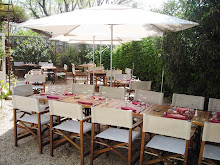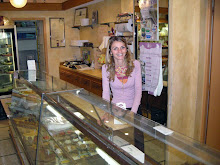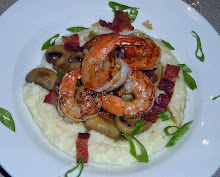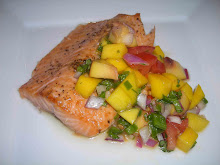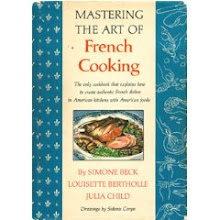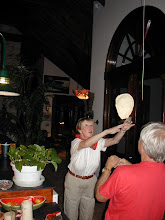Tomates Farcies are very popular in Provence, especially in the spring and summer. Farcies or farci in French means stuffed, most often with finely ground meat. Provence doesn’t just stuff tomatoes. They also stuff all sorts of small vegetables, such as round baby zucchini and petite squashes, small eggplants, and sweet peppers and that dish is called petit farcies. Petit farcies are a Provencal real summer treat and the method is for stuffing them is almost exactly the same as for the tomatoes.
The flesh of the vegetables, in our case tomatoes or tomates as they are called in France, are scooped out and the pulp is minced and put into a bowl with three different kinds of chopped ground meat, finely chopped eggplant, a variety of fresh herbs, a little minced garlic, and a bit of beaten egg, olive oil, milk and flour to hold the mixture together, then the stuffed tomatoes are baked in a hot oven until heated through. They are a perfect warm weather lunch or supper to pair with a crisp green salad and a cool glass of wine.
We had the pleasure of shopping frequently at a small grocery store where we stayed in Maillane that Chef Christopher, a 6th generation butcher, and his wife Claudette owned. Here’s a photo of Christopher clowning around with Meakin one day. Christopher and Claudette are a delightful couple who opened their hearts to us and became a very special part of our time in Provence this year. I’ll save more about them for a later post, but I wanted to share Christopher’s tomates farcies recipe with you before the summer tomatoes disappear. We brought his tomates farcies home from their store for lunch as well as dinner numerous times during our visit.
In Provence there are probably as many recipes for stuffed tomatoes as there are cooks. However I think one of the secrets to the success of Christopher’s tomates farcies, in addition to his delicious stuffing, is that he lets the scooped out tomatoes sit upside down all night so they rid themselves of excess water. I also like the fact that he preserves the tomato tops for presentation. His were much prettier than mine and their tops had a bit of green ends, so I’ve substituted a couple of basil leaves to give them that touch of green. I’ve paired the tomates farcies with an arugula salad with grated Parmesan “snow,” recipe follows.
Tomates Farcies
As told to us by Christopher, a 6th generation French butcher from Provence, serves 4, easily doubled or tripled
Printable Recipe
4 ripe, but firm red tomatoes
Flesh from the insides of the tomatoes, seeds and juices discarded
Good sea salt, preferably French
1 ½ cups of a combination of ground veal, beef and pork, cooked and finely chopped
Peeled and chopped eggplant, about 1 ½ cups
½ cup cooked and chopped button mushrooms, optional
1 small clove of peeled garlic, finely chopped
1 tablespoon finely chopped fresh thyme leaves
1 tablespoon finely chopped fresh rosemary
3 tablespoons finely chopped fresh flat-leaf parsley
Milk to add moisture
1 large egg, beaten to blend
1 tablespoon all-purpose flour
Olive oil for drizzling
Slice off the top of each tomato and set the tops aside for later. If necessary, cut a thin slice from the bottom so the tomato will stand upright. Scoop out most of the flesh of the tomatoes, remove the seeds discard extra juice and set aside to use in the filling. Salt the insides of the tomatoes with good sea salt and set on a rack, upside down to drain overnight in the refrigerator.
The next day remove the tomatoes from the refrigerator and preheat the oven to 350 degrees F.
Place the bread in a bowl with a little splash of milk and let it soak for a few minutes. Meanwhile, in a hot skillet, brown the meat in a little olive oil, breaking the meat up with a wooden spoon as it browns. When the meat is almost done, season with sea salt and freshly ground black pepper and cook until done, then set aside in a large bowl. Add the chopped eggplant, chopped mushrooms (optional) and finely chopped garlic to the meat mixture, then remove to a food processor fitted with a steel blade and process until coarsely ground. Return to the bowl and season with chopped fresh thyme, chopped parsley and a beaten egg. Stir well to combine and add a splash of milk and a tablespoon of all-purpose flour to bind the mixture, and then with a spoon carefully stuff the tomatoes with the meat and vegetable mixture. Place the stuffed tomatoes in an ovenproof pan (it’s okay that they touch), replace the reserved tomato tops and bake for 30 to 35 minutes until the filling is heated through (registers 160 degrees F on an instant read thermometer) and the tomatoes have softened. Carefully remove the tomatoes from the pan and serve either hot or warm.
Cook’s note: Christopher used equal parts veal, beef and pork, but some lamb, which is very popular in Provence, would be wonderful either added to or substituted for one of the other meats in the mixture.
Arugula Salad with Parmesan “Snow”
From My Carolina Kitchen, serves 4, easily doubled
Printable Recipe
4 cups fresh arugula
Good Parmesan cheese
Vinaigrette:
1 tablespoon vinegar of your choice, balsamic, red wine
Maldon sea salt
3 tablespoons extra-virgin olive oil
1 teaspoon Dijon mustard
Freshly ground black pepper
Place a wedge of Parmesan cheese briefly in the freezer for about 20 minutes. In the meantime make the vinaigrette by placing the vinegar, oil, salt and Dijon mustard in a jar with a tight fitting lid, then shake well to mix. Add arugula to a large salad bowl and toss with the vinaigrette. Season with some freshly ground black pepper. Divide the tossed arugula among 4 plates and, using a rasp grater, grate the Parmesan “snow” directly on top of the each individual salad and serve right away.
Today I also have another tomates farcie, which is an old Hoffer family favorite – Tomates Provençal that is paired with chicken breasts with pancetta cream and peas, post and printable recipe link here. Tomates Provençal uses seasoned bread crumbs as a stuffing rather than a meat and vegetable mixture. These tomatoes appear as a side dish on our table almost year-around. Did I hear you say you serve tomatoes in the winter? Well, yes. I find that when you bake tomatoes, the process of baking softens the tomatoes and lets their own flavors shine. If it’s winter when tomatoes aren’t their best, I’ll sprinkle just a tad of sugar in their centers before salting and stuffing them. That little touch of sugar brings out the tomatoes own natural sugars and makes a big difference. But be careful, you don’t want to be able to taste the sugar, so use a light hand.
Tomates Provençale
An old Hoffer family favorite, serves 4, easily doubled or tripled
Printable Recipe
Preheat the oven to 400 degrees F. Cut the stem end off of each tomato and remove about a third to half of the core and discard. If necessary, cut a thin slice from the bottom so the tomato will stand upright. Sprinkle the insides of the tomatoes liberally with good sea salt and turn the tomato over and let drain on a rack or paper towels. In a bowl mix together equal parts seasoned dried bread crumbs and Panko bread crumbs with your choice of chopped fresh herbs (I like flat-leaf parsley, thyme and rosemary, or if fresh basil is in season, use in place of the rosemary). Drizzle a little good extra-virgin olive oil in the crumb mixture and mix until it comes together, then stuff the crumb mixture into the tomatoes, mounding on top with a spoon.
Place the tomatoes, crumb side up, in an ovenproof pan and drizzle a little more extra-virgin olive oil over the tops, letting some fall into the pan. It’s fine if the tomatoes touch. It helps them hold themselves upright. Roast for 20 to 25 minutes until the tops are golden and the tomatoes have started to soften. Check the tomatoes at 15 minutes to make sure the crumbs aren’t burning. Serve hot, warm, or at room temperature as a side dish.
Variations: Add a small piece of raw bacon on top of the crumbs before placing in the oven. Include some finely chopped garlic in the crumb stuffing. Vary the fresh herbs according to your taste.
For better viewing, click photos to enlarge.
This will be shared with Foodie Friday at Rattlebridge Farm and Miz Helen’s Country Kitchen Full Plate Thursday.
Have a great weekend everyone.


































































